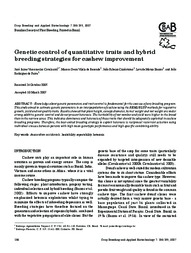Genetic control of quantitative traits and hybrid breeding strategies for cashew improvement.
Genetic control of quantitative traits and hybrid breeding strategies for cashew improvement.
Summary: Knowledge about genetic parameters and trait control is fundamental for the success of any breeding program. This study aimed to estimate genetic parameters in an interpopulation of cashew using the REML/BLUP methods for vegetative growth, yield and nut quality traits. Results showed that plant height, canopy diameter, kernel weight and nut weight are under strong additive genetic control and do not present heterosis. The heritability of nut number and yield were higher in the broad than in the narrow sense. This indicates dominance and heterosis of these traits that should be adequately exploited in cashew breeding programs. Therefore, the best-suited breeding strategy to exploit heterosis is reciprocal recurrent selection using individual crosses between parents with high mean genotypic performance and high specific combining ability.
Publication year: 2007
Types of publication: Journal article
Unit: Embrapa Forestry
Keywords: Anacardium Occidentale, Caju, Programa de melhoramento
Observation
Some of Embrapa's publications are published as ePub files. To read them, use or download one of the following free software options to your computer or mobile device. Android: Google Play Books; IOS: iBooks; Windows and Linux: Calibre.
Access other publications
Access the Agricultural Research Database (BDPA) to consult Embrapa's full library collection and records.
Visit Embrapa Bookstore to purchase books and other publications sold by Embrapa.

